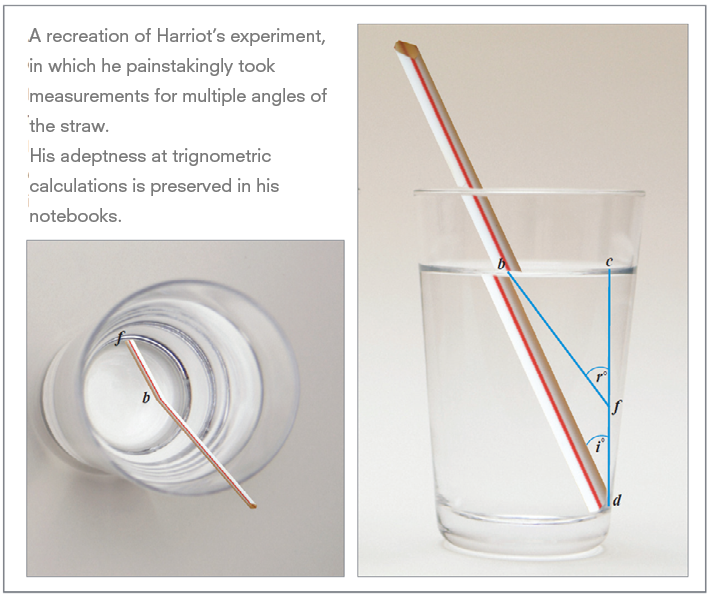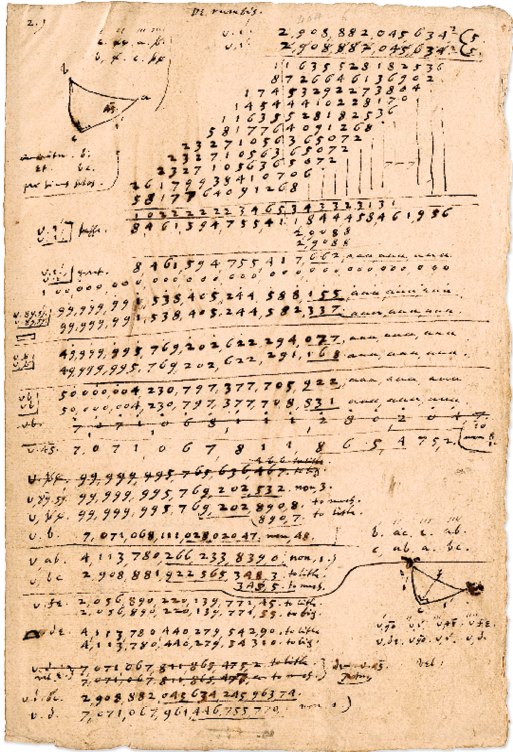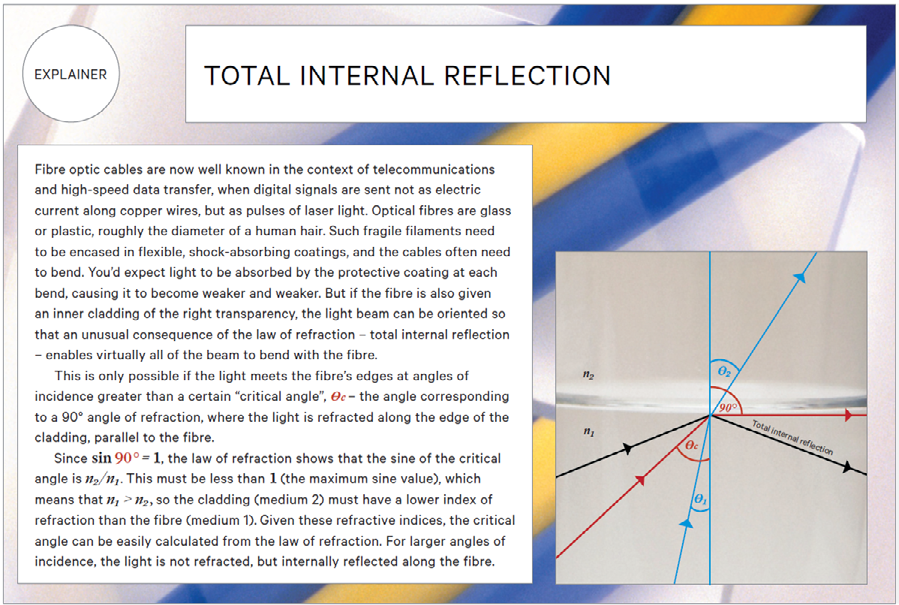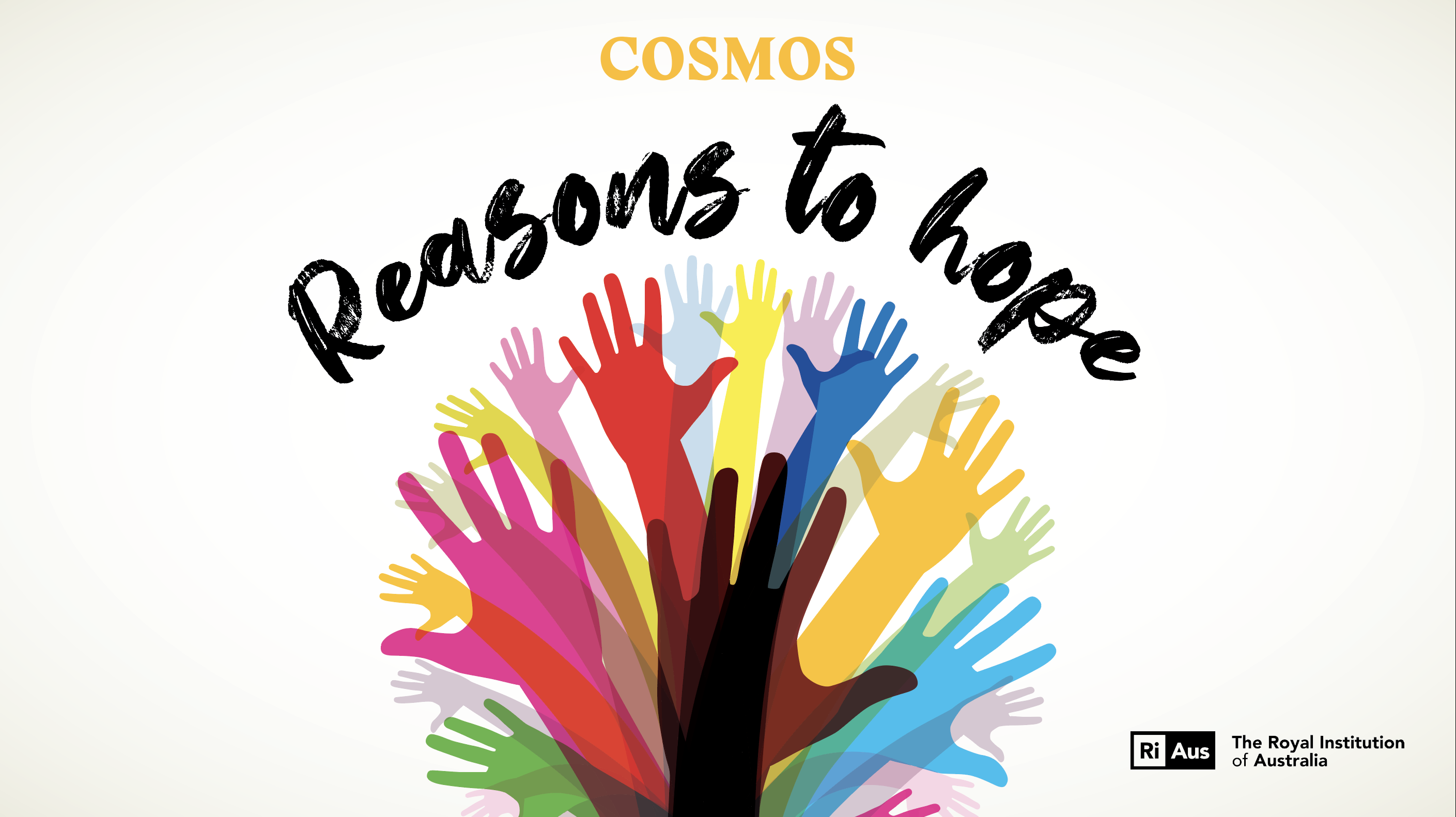Before Galileo, Descartes and Newton, Thomas Harriot made some of the breakthroughs ascribed to his famous peers – but as Robyn Arianrhod explains, it’s his investigation into an everyday occurrence that shows just what it takes to discover a scientific law.
This article from Cosmos magazine issue 85 and associated activity would be suited to students in years 8, 9, 10, 11, and 12 studying Physical and Chemical Sciences.
Word Count: approx. 3300
Thousands of years ago people must have wondered at the shadowy images reflected back at them from pools of water. The great thing about science, of course, is that wonder leads to curiosity, and eventually someone figured out the law of light reflection. It’s incredibly simple but marvellous nonetheless, because it’s one of the first ever laws of physics.
It says that when a light ray is reflected, it makes the same angle with the reflecting surface as the incoming beam, and that both beams lie in the same plane. Its discoverer is lost in time, but Euclid and Aristotle left written references to it, several hundred years before the Common Era.
Surprisingly, it took 2000 more years for someone to discover the law describing another simple trick of the light: refraction.
You may not know the maths, but you’ll be familiar with the phenomenon. It shows up in the way your feet seem askew when you step into ankle-deep water, or the way the lower part of a drinking straw in a glass of water seems to bend towards the liquid’s surface. Dutch astronomer and mathematician Willebrord Snell found the long-sought mathematical relationship – widely known as Snell’s law – some time around 1621. It predicts the precise angle through which a given ray of light will bend when refracted into a different transparent medium.
Snell didn’t publish his discovery, and no-one really knows how he arrived at it – his only surviving manuscript on the subject gives just a brief, geometrical outline of the law that now bears his name. There is no extant evidence of his carrying out measurements of angles, and he didn’t specifically give numerical values to various substances’ light-bending qualities (known now as indices of refraction). It turns out, though, that someone else did – 20 years before Snell. This mysterious Elizabethan didn’t publish his discovery either, but he left scores of manuscript pages that show just how he did it. His name was Thomas Harriot.
What is the law?
First, though, some background. The law of refraction is more complicated than a simple proportional relationship between angles, as in the law of reflection. Instead, it says that the ratio of the sines of the angles of incidence and refraction is constant.
The ability to predict the amount of bending when a light beam meets a transparent surface such as water or glass has many applications: the design of high-precision lenses for telescopes, microscopes and cameras; explaining why rainbows form; determining the true depth of an underwater object; remote sensing devices; correcting for atmospheric refraction in astronomy; and many more. Closer to home, there’s a rather surprising and very significant application: fibre optics.
Many readers will recall doing simple lab experiments in physics class to confirm the law of refraction. In one such setup, students shine a beam of light across a circular disc with a scale marked on it like a protractor; a plastic semicircular lens in the middle of the disc refracts the beam, and the angles of incidence and refraction can be measured from the scale. Rotating the disc (or the light beam) allows many pairs of angles to be measured, and students can verify that the ratio of the sines of each pair of angles is the same.
Of course, in centuries past there were no handy sources of narrow, focused light beams – and, more importantly, there was no hindsight.
How did we get there?
The earliest known account of a search for the secret of refraction is in the second century work Optics by Claudius Ptolemy of Alexandria. He measured a number of angles of incidence and refraction and thought that they were proportional to each other, but couldn’t find an exact ratio that covered all possible angles. Nine centuries later, not even the greatest of all medieval optical researchers, Abu Ali Ibn al-Haytham, was able to uncover the elusive law.
One of the exciting things about the history of science is that there’s always scope for rewriting or reinterpreting the history books. Recently discovered manuscripts by Ibn al-Haytham’s predecessor, the 10th century Baghdad-based scholar Abu Sa’d al-‘Ala’ Ibn Sahl, appear to show that in his analysis of lenses he used a geometric construction that illustrates the correct relationship between incident and refracted rays.
But does this qualify as the discovery of a new law of physics?
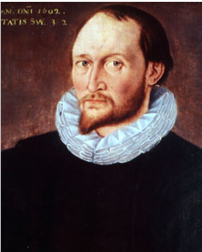
A number of scholars say no. The scientific method requires laws of physics to be derived from the real world by experiment, or from a quantitative mathematical theory that can be tested by experiment. Roshdi Rashed, who discovered and reconstructed Ibn Sahl’s lost manuscripts, admits that, “At no time does any kind of experimentation whatsoever intervene as part of the proof.” Rather, Ibn Sahl was trying to show geometrically how to construct the best lenses for focusing light so that it could be used for burning. He wasn’t looking for a law of refraction, and he certainly didn’t generalise his result to all refractive media.
What’s more, even with his single pair of media – the air and the lens – “the sine ratio, or its reciprocal, is never stated as a constant, nor is it assigned a numerical value or supported by theoretical considerations of any kind”, as the late professor of the history of Islamic science Abdelhamid Sabra put it.
It may seem extraordinary that an adequate derivation of this relatively simple law eluded the greatest scientific minds for 2000 years. A closer look, however, shows the importance of motivation and method. Ibn Sahl’s motivation appears to have been purely practical – burning lenses. While technological needs have always been drivers of science, the discovery of fundamental laws of physics generally requires the desire to understand the natural world just for its own sake. Yet even the most passionate curiosity may not be enough if there’s no clear way ahead.
Today, we take the scientific method for granted, but even in Snell’s time physics hadn’t yet become a separate discipline with its own methodology, distinct from the magic, theology and philosophy that also underpinned the natural human drive to understand the universe.
Until Newton and his modernising 18th century disciples, there simply wasn’t a “road map” – no articulated, widely accepted dictum about replicating experiments independently, basing hypotheses on solid data and expressing them quantitatively so that their predictions could be tested.
Instead, most “natural philosophers” mixed commonsense observation and rational deduction with wild, often mystical speculation in order to make sense of nature. There was a problem with language, too. Definitions of concepts that are now considered fundamental – such as acceleration, force, and even the index of refraction – had not yet been wrestled into a coherent, quantitative form. As for experiments, the inherited medieval tradition had focused on “thought experiments” – such as hypothetical designs for lenses – justified by reason rather than physical testing.
No-one had had the patience to undertake the measurements required to quantify refraction.
Of course, there’d always been occasional geniuses intuiting something akin to the “Newtonian” method. Galileo, for instance, was one of the small but growing band of early 17th century researchers who did carry out careful experiments – in his case, most notably on falling motion. Johannes Kepler – famous today for his marvellous, observation-based discovery of the laws of planetary motion – was also interested in refraction, but when he intensified his hunt for the elusive solution in 1602, he relied on Witelo’s medieval version of Ptolemy’s 1450-year-old tables of angles of incidence and refraction. It seems no-one else had had the determination and patience to undertake the meticulous measurements needed to quantify the bending of refracted light. No-one, that is, until Thomas Harriot turned his mind to the topic.
Harriot’s Work
One of the best astronomers of his era, Harriot was a young Oxford graduate in the early 1580s when he began his career as a navigational advisor to Sir Walter Ralegh (or Raleigh: spelling wasn’t fixed at the time, and Ralegh himself used various versions of his name, most often Ralegh). By the early 1590s, the colourful and controversial Ralegh had fallen from Queen Elizabeth’s favour, and soon afterwards he and Harriot had also fallen foul of key religious authorities, who looked askance upon their free-thinking approach to science. (Galileo famously suffered under similar suspicion.) It was a stressful time, but one of Ralegh’s friends – Henry Percy, the Ninth Earl of Northumberland – was so impressed with Harriot’s inquiring mind that in 1597 he offered to take over as his patron. With this newfound financial security, Harriot began to explore the question of refraction.
His first measurements were taken on 11 August, 1597, but in modern scientific style he also took them the next day, and again on August 21. He carried out these early observations by immersing a stick and marking off the position of its image when viewed through the water.
You can get the idea by dropping a straw into a glass of water. Hold the straw at an angle, and if you look at the top of the water, you see the immersed part of the straw bent towards the water surface. Put your finger on the outside of the glass, level with where the bottom end of the refracted image of the straw appears to meet the side of the glass: the point marked f in the diagram below. Looking from the outside of the glass you will see that your finger points to a spot that is higher than the actual lower end of the straw, marked d. Harriot marked off these points carefully, repeating the process as he changed the angle of the stick.
It takes a dexterous and persistent experimenter to take measurements using this method.
After taking these measurements, Harriot used them to calculate, from trigonometric tables, the various pairs of angles of incidence and refraction. In other words, he didn’t directly measure his angles of incidence and refraction (designated here as i and r), but calculated them from his measurements of the image of his stick via the trigonometric ratios sin r = bc/bf and tan i = bc/cd.
As you might have noticed in your straw experiment, it takes a dexterous and persistent experimenter to take reasonably accurate measurements using this method, and Harriot eventually devised a better approach. He didn’t have a convenient rotating protractor, plastic prism and narrow beam of light, but he did have a handy astrolabe – a disc with a scale marked around the edge for taking astronomical observations. So, in 1601, he experimented with immersing his astrolabe in water, its circular scale making it a convenient protractor.
When he plotted his observed refracted images of these scale marks, he found that, within the limits of experimental approximation, they all lay on a smaller, concentric circle inside the circle of the actual astrolabe scale. He had arrived at a geometric form of the sine law of refraction, akin to that defined by Ibn Sahl and later Snell – except that Harriot’s was more detailed, and was clearly constructed from experiment.
And unlike the others, Harriot used his diagram to calculate the refractive index of air with respect to water – where the refraction is measured for light going from the water into the air: his result of 0.748955 is within 0.5% of the modern value. He also realised that these indices hold in reverse, so that the index of refraction for light going from air to water is the reciprocal of the index from water to air.
Then he went even further – and in doing so showed just what it takes to discover a general law of nature. He’d already demonstrated the importance of the repeated, replicable measurements that now underpin the modern scientific method – but only for refraction from air into water. So he painstakingly set about measuring the angles for light going from air to water, from air to glass, and from water to crystal.
In each case, the ratio of sines was constant, although the value was different for each different pair of media – so he’d found that each refracting substance has its own refractive index. And once again, he calculated his indices to six decimal places.
But there’s still more to Harriot’s discovery. He was not only one of the best astronomers and best experimenters of his time, but also one of the best algebraists. He was the first to use a fully symbolic, recognisably modern form of algebra – traditionally, it was done in the form of word problems, and even by 1600 relatively few symbols were used. He also implicitly recognised the concept of algebraic trigonometric functions – as opposed to the geometric measurements of the sides of triangles used by Ibn Sahl as well as Snell and his contemporaries.
Harriot was so advanced in this that he had to invent his own symbols for trigonometric functions. He used a kind of U symbol for sines – as on the left of the image above, and in the remarkable manuscripts where he uses the modern algebraic form of the sine law. In the case of air and water he takes the sines of various angles of incidence and multiplies them by the refractive index 0.748955. This gives him the sines of the corresponding angles of refraction. It’s an extraordinary enough experience simply sifting through his pages and pages of calculations, lost to history for so long. Imagine the patience required just to carry out the long multiplications by hand. You can feel the effort when you look at his work, where he’s multiplying out, in a different context, sine values with 13 significant figures!
Harriot didn’t rush into print with his general law of refraction – he rarely got around to writing up his research, let alone publishing it. Instead, his algebraic version of the sine law appears in the calculations for his own tables of refraction for several different media. The tabulated angles of incidence run degree by degree from 1° to 90°, and in each case the corresponding angles of refraction are found from the sine law in the form sin r=k sin i, using his experimental values of k, and interpolation of sine tables.
That’s 90 separate calculations for each table, all done by hand to six decimal places, and systematically set out around the explicit sine law. It was an extraordinary achievement.
Kepler’s Interest
Harriot had found his law by 1601, but Kepler wasn’t having the same success. He’d recognised some fudging in Ptolemy’s figures but his own experiments frustrated him; in May 1603, he wrote to a friend: “Measuring refractions, here I get stuck. Good God, what a hidden ratio!”
Finally, in 1606, he wrote to Harriot. A mutual acquaintance had told him of Harriot’s success, and Kepler sent a letter requesting Harriot’s laborious experimental measures. But Harriot was exhausted. He’d continued to act as Ralegh’s accountant, and had helped prepare evidence for him in his treason trial at the end of 1603. Then, at the end of 1605, Northumberland, too, was imprisoned, swept up in the political paranoia that followed the Gunpowder Plot. Harriot himself was tainted by association and spent an anxious three weeks in prison.
He replied to Kepler that his poor health meant “it is difficult for me to write or think or argue clearly about anything at the moment”. He held back from sending his hard-won refraction data, forwarding instead a sample of measurements to clarify a misunderstanding that Kepler had expressed in his letter, about the relationship between refraction and density.
Kepler also wanted to know about Harriot’s reputed discoveries on rainbows. These were new and unfinished results, but Harriot told Kepler that rainbows are formed because light is reflected and refracted through each raindrop – something he’d worked out himself, although historians now know that several 14th century scholars in Persia and Europe had come to the same conclusion.
Harriot said he would tell Kepler more about his rainbow theory when he had more time and energy to write up his work, which he never got around to. He was often sidetracked by the needs of his patrons and the dramas surrounding them in their political misfortunes. Nevertheless, his manuscripts reveal the amazing breakthroughs he’d hinted at.
First, he discovered the phenomenon of dispersion – the splitting of sunlight into colours via refraction through a prism – half a century before Newton famously rediscovered it. Careful quantifier that he was, Harriot measured the amount of bending for various colours, and found that different colours have a different index of refraction in the same pair of media. Unlike Newton, he focused only on two or three colours. Still, he’d made a remarkable discovery, and he went on to find the different colour indices for a variety of media.
Finally, using the law of reflection and his new law of refraction, he gave a brilliant mathematical analysis showing why the rainbow has its characteristic size and shape, anticipating René Descartes by several decades.
The unrecognised genius
In the following years, Kepler took the study of optics into new territory, publishing a seminal work on geometric optics and the nature of vision in 1604 – the most substantial advance since Ibn al-Haytham – and a work on refracted images in 1611. He never did find the correct law of refraction.
As for Harriot, he went on to make further unpublished breakthroughs, but he died in 1621 and his manuscripts were lost for 150 years. Even after their discovery in an ancient English castle, most of the 8000 rediscovered pages remained unstudied for two more centuries.
Word of Harriot’s genius began to get out in the latter half of the 20th century but it is only recently that scholars have collectively attained a clear understanding of his broad-ranging research. He not only discovered Snell’s law before Snell and the secret of the rainbow before Descartes and Newton, he found the law of falling motion independently of Galileo, used a telescope to study the moon and sunspots – again independently of Galileo – and made many other original discoveries in mathematics and physics.
He never achieved the fame he deserved, and there are few surviving clues as to what he was like. Yet his presence felt palpable when I held his quill-penned, 400-year-old manuscripts in the British Library and studied them for myself. They embody his power of concentration and the breadth and depth of his enquiring mind. Occasionally they reveal an idle doodle, or a shopping list scribbled in the margin.
But it’s the pages showing his geometric presentation of the sine law, and the neat, laboriously calculated tables of refraction built explicitly around the algebraic form of the law, that stand out from most of his papers. They’re discoloured with use. I can’t think of a more eloquent testament to their importance, first of all to Harriot, who surely used them in his further optical researches, and now to modern historians.
This article was written by Robyn Arianrhod, affiliate in the School of Mathematics at Monash University, for Cosmos Magazine Issue 85.
Cosmos magazine is Australia’s only dedicated print science publication. Subscribe here to get your quarterly fill of the best Science of Everything, from the chemistry of fireworks to cutting-edge Australian innovation.
Login or Sign up for FREE to download the educational resources


